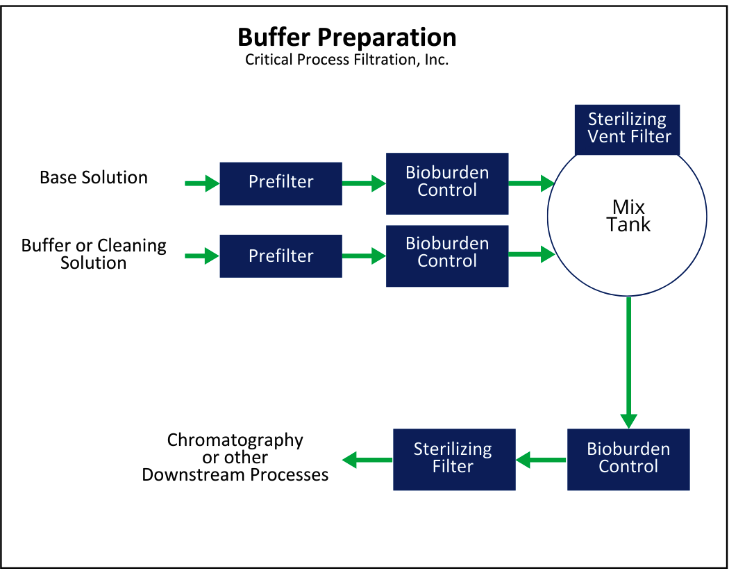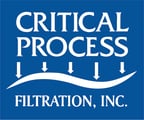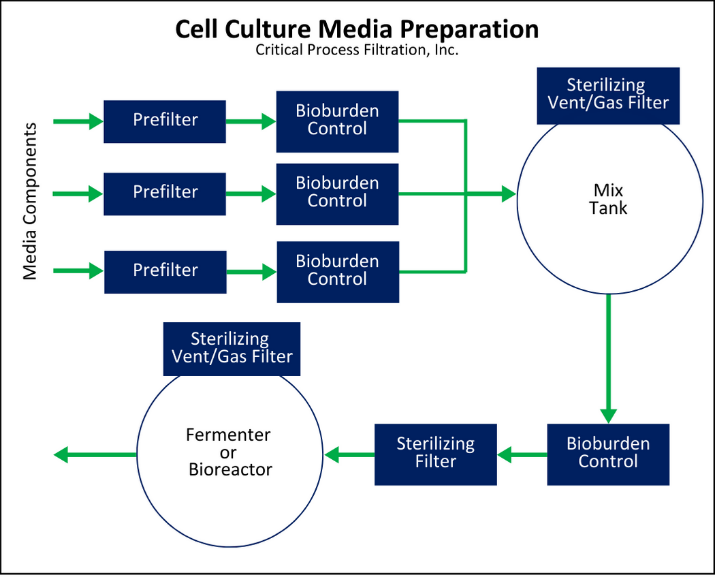Whether you are developing cell culture media and buffers for in-house use or marketing a commercial product, filtration is critical in maintaining the appropriate artificial environment conducive to the cells’ survival and propagation.
The efficiency of fermenters, bioreactors, and downstream processes is greatly enhanced by removing unwanted particles, bacteria, mold, yeast, and other contaminants present in the media components, both natural and artificial. Filtration will ensure the sterility of working solutions, solutions prepared from the dilution of concentrates, and solutions prepared from dissolving powders.
Media can be made up of numerous ingredients that are either mixed onsite or purchased pre-mixed. Filtration of ingredients can range from particle removal to bioburden reduction or to the sterilizing of biological fluids and nutrients (salts, vitamins, gases, serum, etc.).
Process buffers are used in diafiltration processes, as diluents for solutions entering chromatography columns, and as solvents or carriers for proteins. As with culture media, buffers are often made up of multiple ingredients mixed on-site or purchased pre-mixed. They too may contain contaminants detrimental to the final product.
Preparing Cell Culture Media
Figure 1 is a schematic of a generic cell culture media preparation system. Once mixed, culture media is usually added to the fermentation tank or bioreactor on a batch basis. Some operations employ continuous processing. In those cases, the cell culture media preparation system will feed directly into the fermenter or bioreactor during the entire production run, without an intermediate mixing tank.
As components are delivered to the mix tank, filters remove particulates and/or bacteria that may be in them. Because the media, by its nature, promotes the growth of bacteria, assuring that unwanted bacteria are removed also assures the safe and effective operation of the fermenter or bioreactor.
If a mix tank is used, vent or process gas filters are used to maintain the quality of the solution in the tank. These filters protect the tank contents from particles and bacteria in the surrounding air or process gas that may be used as a blanket over the solution in the tank.
While the schematic shows one mix process, there may be multiple media prepared and fed to the fermenter or bioreactor. There may be multiple mix tank and feed systems in place, or some media may be purchased from an outside source and delivered in rigid, reusable containers or flexible, disposable packages. In either case, the filtration needed to promote good system operation remains the same.
For commercial suppliers of cell culture media, the filtration strategy for ingredients (water, nitrogen, trace elements, and growth factors) is the same as the in-house operation with the exclusion of the bioreactor/fermenter and sending the sterile media to packaging.
Figure 1: Cell Culture Media Preparation
Buffer Preparation
Figure 2 is a schematic of a generic buffer mix system delivering the buffer to a chromatography column. The buffer could also be delivered to several other downstream processes. The buffer preparation process is similar to cell culture media preparation. Individual components, usually water, salts, and pH-adjusting chemicals, are individually filtered and mixed in a tank. The finished solution is then delivered to the appropriate process. Buffer preparation is most frequently a batch process, but some operations utilize continuous processing. Those systems must provide a steady stream of filtered buffer for the entire production run.
As the components are delivered to the mix tank, filters are used to remove particulates or bacteria. Downstream purification processes that use the buffers are sensitive to bacteria and particle contamination. To allow those processes to operate as intended, the finished buffer solution is filtered to remove those contaminants. If a mix tank is used, the solution is protected from particle and bacterial contamination by a vent or process gas filter, depending on whether the tank is vented to the atmosphere or a process gas blanket is used over the solution in the tank.

Figure 2: Buffer Preparation
Both Figure 1 and Figure 2 show typical filter applications. These filters are positioned to prevent fouling of downstream processes such as chromatography and diafiltration. Additional filters may be required if either the solution components or the mixed solution contain materials such as gels or colloids. These deformable particles can cause premature filter plugging. Installation of additional prefilters, or incorporating a prefilter layer into the bioburden reduction or sterilizing filters may be required to remove these contaminants.
Filter Applications
Particle Removal
Prefilters are employed to remove unwanted particles that may be entrained in the feed streams or mixtures. The figures only show prefilters at the point of entry for solution components. Depending on the particle load in the components, and the nature of the mixing processes, prefilters may be required in multiple locations.
These prefilters are designed to capture larger particles that could prematurely foul bioburden reduction and sterilizing filters. They are most often used to remove inorganic particles such as undissolved powders and similar contaminants. Some large organisms, such as molds or yeasts, can also be captured by these filters. Depth filters are commonly employed for this step. Pleated filtration products, with large filtration media surface areas, can remove several times more particle contaminants than standard melt-blown or nano-spun depth filters.
Bioburden Reduction
Filters that are designed to remove most, but not necessarily all bacteria (bioburden) are designated as bioburden reduction or bioburden control filters. The filter micron rating may be 0.22 μm, 0.45 μm, or even 0.65 μm depending on the target organisms to be removed. These are generally used to relieve some of the burden on final, sterilizing filters.
Depending on criticality, operators may elect to employ sterilizing filters in the locations marked as bioburden reduction in the schematics. To decide which, several factors must be considered:
- Likelihood of bacterial contamination in products delivered from a vendor
- Level of contamination that might be encountered
- Adequacy of cleaning/sterilizing procedures for the delivery and tank system
- The burden placed on downstream sterilizing filters if an upstream sterilizing filter is not employed
- How conducive is the formulation to bacterial growth?
If bacteria can easily propagate in the product, then a sterilizing filter is the best choice. If not, a less expensive bioburden reduction filter could be employed.
Sterilizing Filters
Sterilizing grade filters are rated to remove particles and bacteria that are 0.22 or 0.10 microns in size. These filters are shown in only one in the schematics above, but as noted may be used in the locations marked as bioburden reduction depending on criticality. The media must be free from bacteria that would interfere with the cell culture process, so a sterilizing filter will be the last step as the media is introduced to the fermenter or bioreactor. In buffer preparation, bacteria are removed as the solution is introduced to the mix tank, filtering a smaller stream to remove bacteria with fewer filters. The final buffer solution is then filtered just before its use in a column or other process, as further assurance against potential contamination.
Tank Vent and Gas Filters
Tank vent filters are used to protect the media or buffer solutions stored in tanks from bacterial and particulate contamination. As a tank is filled, the air inside must be allowed to escape. However, as the tank is emptied, air (or a process gas such as nitrogen) must be allowed to enter the tank to replace the lost liquid volume. The filter removes particle and bacterial content from the air or gas to assure the quality of the solution. The vent filter membrane must remain dry so that air or gas can pass freely through the filter. To assure that dryness, filters are made using hydrophobic membranes, usually PTFE.
NOTE: Vent filters play a critical role in the design of tank systems. Stainless steel tanks are susceptible to collapse if subjected to vacuum conditions. It is critical to properly size the filter to allow the airflow required at the maximum rate of tank outflow with a pressure drop well below the vacuum rating of the tank. Improper sizing can result in permanent tank damage. Tanks should also have rupture discs, vacuum switches, or other features to protect against accidental pressure or vacuum excursions that might cause tank failure. If a large, flexible, collapsible bag is used instead of a tank, the bag will expand and collapse without the need to allow air into the container. Vent filters are not required for flexible bag containers.
Choosing the Right Filters
Absolute-rated membrane filters with a pore size of 0.22 microns or less are considered to be sterilizing. Depending on the application or nature of known potential contaminants, 0.10-micron filters can be employed.
Critical Process sterilizing grade filters have been validated for > 7-log bacteria removal following ASTM-838-15 protocols. CPF will provide a validation guide for the filter(s) chosen, documenting test results for bacteria retention, and information regarding filter construction, biosafety, and performance. The final choice of pore size often requires validation testing in the actual fluid to be processed.
The filter(s) selected must be compatible with the fluid being filtered and process disinfection/sterilizing methods. The filter(s) must also be capable of removing target organisms without affecting the composition or activity of the fluid being filtered.

